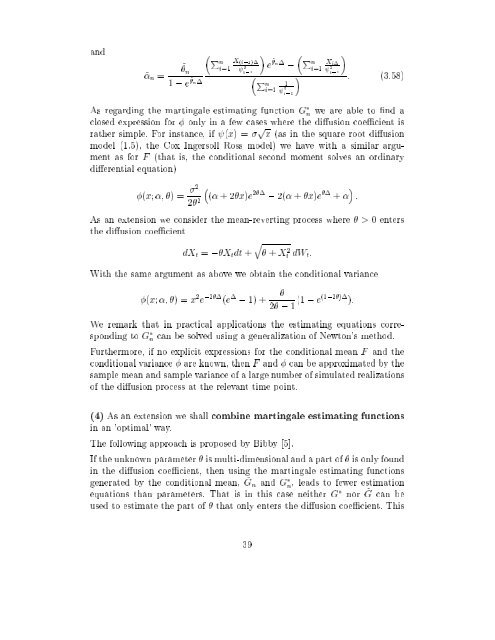Estimation in Financial Models - RiskLab
Estimation in Financial Models - RiskLab
Estimation in Financial Models - RiskLab
Create successful ePaper yourself
Turn your PDF publications into a flip-book with our unique Google optimized e-Paper software.
and<br />
~ n =<br />
~ n<br />
1 , e ~ n<br />
<br />
Pni=1 X (i,1)<br />
2<br />
i,1<br />
<br />
e ~ n<br />
,<br />
<br />
Pni=1 X i<br />
2<br />
i,1<br />
<br />
Pni=1<br />
1<br />
2<br />
i,1<br />
<br />
: (3.58)<br />
As regard<strong>in</strong>g the mart<strong>in</strong>gale estimat<strong>in</strong>g function G n we are able to nd a<br />
closed expression for only <strong>in</strong> a few cases where the diusion coecient is<br />
rather simple. For <strong>in</strong>stance, if (x) = p x (as <strong>in</strong> the square root diusion<br />
model (1.5), the Cox Ingersoll Ross model) we have with a similar argument<br />
as for F (that is, the conditional second moment solves an ord<strong>in</strong>ary<br />
dierential equation)<br />
(x; ; ) = 2<br />
2 2 <br />
( +2x)e<br />
2<br />
, 2( + x)e + :<br />
As an extension we consider the mean-revert<strong>in</strong>g process where > 0 enters<br />
the diusion coecient<br />
q<br />
dX t = ,X t dt + + Xt 2 dW t :<br />
With the same argument as above we obta<strong>in</strong> the conditional variance<br />
(x; ; ) =x 2 e ,2 (e , 1) +<br />
<br />
2 , 1 (1 , e(1,2) ):<br />
We remark that <strong>in</strong> practical applications the estimat<strong>in</strong>g equations correspond<strong>in</strong>g<br />
to G n can be solved us<strong>in</strong>g a generalization of Newton's method.<br />
Furthermore, if no explicit expressions for the conditional mean F and the<br />
conditional variance are known, then F and can be approximated by the<br />
sample mean and sample variance of a large number of simulated realizations<br />
of the diusion process at the relevant time po<strong>in</strong>t.<br />
(4) As an extension we shall comb<strong>in</strong>e mart<strong>in</strong>gale estimat<strong>in</strong>g functions<br />
<strong>in</strong> an 'optimal' way.<br />
The follow<strong>in</strong>g approach is proposed by Bibby [5].<br />
If the unknown parameter is multi-dimensional and a part of is only found<br />
<strong>in</strong> the diusion coecient, then us<strong>in</strong>g the mart<strong>in</strong>gale estimat<strong>in</strong>g functions<br />
generated by the conditional mean, ~G n and G n, leads to fewer estimation<br />
equations than parameters. That is <strong>in</strong> this case neither G nor ~G can be<br />
used to estimate the part of that only enters the diusion coecient. This<br />
39
















